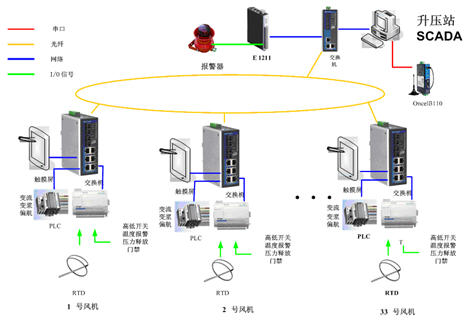With the development of modern industry, the demand of human beings for energy is also increasing day by day. However, the scarcity of available energy makes the countries of the world pay close attention to the development of new energy and renewable energy. As wind power is one of the main ways to reduce CO2 emissions, governments of all countries have indicated that they will continue to support their wind power industry in terms of policies. The installed capacity of wind power in China rose from 402,000 kilowatts in 2001 to 12.15 million kilowatts in 2008. Since 2004, the installed growth rate of wind power in China has continued to exceed the global average. By 2020, China's wind power capacity will exceed 100 million kilowatts.
As the distance between each unit of the wind farm is less than a few hundred meters, and many are public, in order to reduce the loss of the output power of the fan and stabilize the voltage, each fan needs to be equipped with a box-type transformer, and then incorporated into a 100KV step-up substation to the grid. . Therefore, in a large-scale wind farm, how to improve the monitoring of box changes is very important. The traditional monitoring system mainly achieves remote scheduling through the microcomputer integrated protection of the booster substation. The current wind farm adopts an unattended and remote monitoring method. Therefore, the detection of various indicators of the box change through the network is the best solution to the problem. Not only can the centralized monitoring of parameters be achieved, but also the efficiency of management and the real-time nature of data can be improved, so that maintenance personnel can make decisions in a timely manner and provide reliable protection for the wind power grid connection.
system requirement
Need to collect multiple transformer status points, including: oil temperature, pressure, alarm switch, gas protection and other data easy to integrate existing Ethernet network programming is simple, easy to maintain timing, real-time reporting mechanism wide temperature, suitable for on-site harsh environment low power consumption Compact designMoxa solution
Moxa's first-generation wind generator ioLogik E2242 supports 4 AIs and 12 DI/Os to meet the needs of multiple data acquisition points in case changes. In addition, the ioLogik E2242 provides Ethernet ports, which can be connected to the on-site switches and upload the collected data directly to the main control room through the network, thus enabling the remote monitoring of the wind chassis through the network. Moxa will launch the second-generation wind turbine monitoring and monitoring machine E1261, which will meet the needs of the site more.
In this case, a wind farm has a total of 33 1.5MW wind turbines, each with a box change, so an ioLogik E2242 (or E1261) is used in each box change to collect the oil temperature in the box change. , pressure, alarm switch, gas protection and other parameter data. The ioLogik E2242 (or E1261) is connected upstream to the field switch. All switches form a fiber ring network to ensure that data can be uploaded to the SCADA system in real time. Based on this architecture, the customer can realize the on-line monitoring function of the wind chassis with minimal investment. Once a problem occurs, the system will automatically alarm, greatly reducing the personnel's business trips and the cost of equipment maintenance.
Moxa's Ethernet I/O requires no programming. The built-in Click&GoTM software setting function can complete front-end data acquisition, processing, and communication tasks within milliseconds. In addition, Active OPC Server is supported to be compatible with SCADA systems and provide seamless integration of ioLogik products and SCADA systems. Different from the traditional polling method, the Active OPC Server can provide Push communication with the HMI/SCADA system through Moxa ioLogik series products, and at the same time provides instant I/O status report. Because of this, this kind of active communication method makes the ioLogik initiative to send an incident report only when the event is driven, compared to the traditional polling method, which can reduce the bandwidth occupancy rate up to 80%, and the I/O response speed is also improved. 7 times. In addition to the Active OPC Server, ioLogik also provides Modbus/TCP and MXIO for easy integration with HMI/SCADA systems.
In this wind chassis change online monitoring system, the customer integrates the ioLogik E2242 (or E1261) with the remote SCADA system to achieve local data acquisition, monitoring, and real-time data transmission to the SCADA system over the network. The original hardware and software investment in the system are completely preserved, and no adjustments are required, thus protecting the customer's initial investment. The ioLogik E2242 (or E1261)'s high efficiency, high stability, and strong compatibility are highly appreciated by customers and will be increasingly used in wind power box change online monitoring systems in the future.

System configuration diagram
Why Moxa?
The ioLogik E2242 (or E1261) supports multiple I/O types to meet the needs of on-site box monitoringioLogik provides RJ-45 Ethernet port for easy integration of existing Ethernet networks. Click&GoTM is supported. Simple programming and easy maintenance. Support timing, real-time reporting mechanism Supports -40~75°C, suitable for harsh environments on site Low power consumption, compact design
Moxa's over 20 years of product experience in industrial equipment
Application product introduction
ioLogik E2242
4 differential analog input channels12 DI/DO configurable channels Report events instantly via TCP, UDP, e-mail, and SNMP Trap Configure via Utility and web Simple and easy-to-use Click&Go Logic for local control
Connector Socket Series,Automotive Connector Sockets,Car Antenna Connectors,Custom High Speed Connectors
Shenzhen huaxunde Technology CO.,Ltd. , https://www.huaxundekj.com